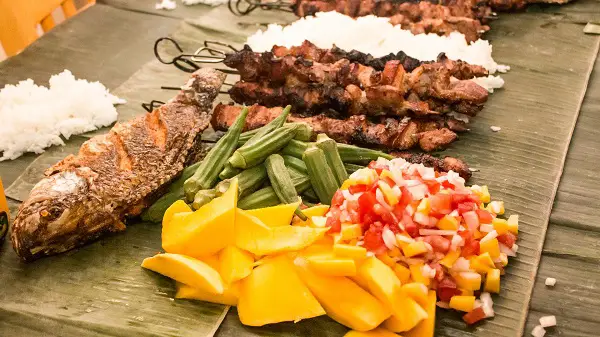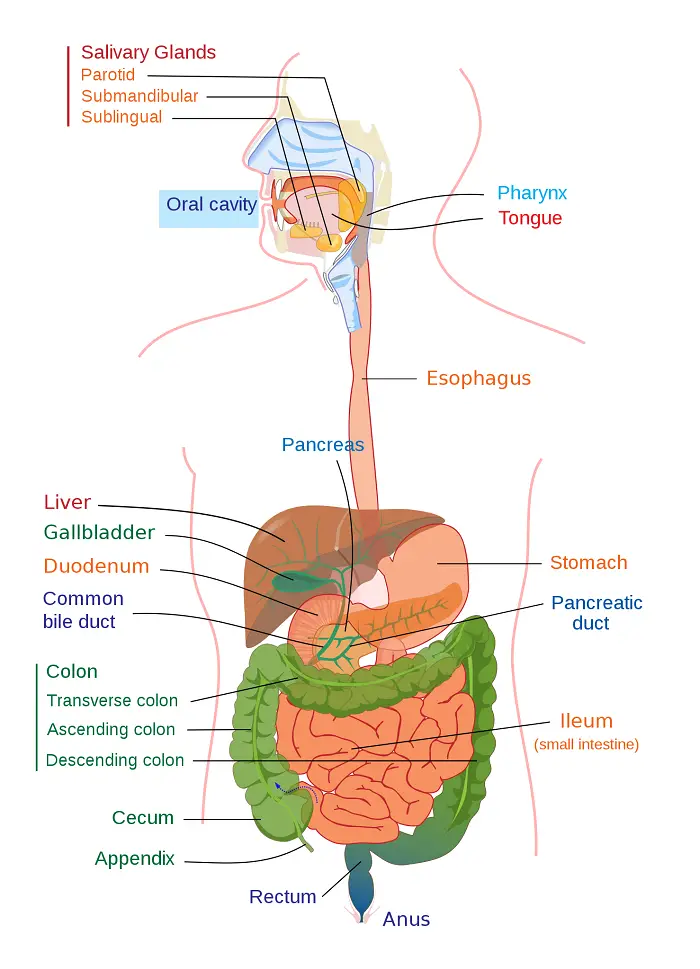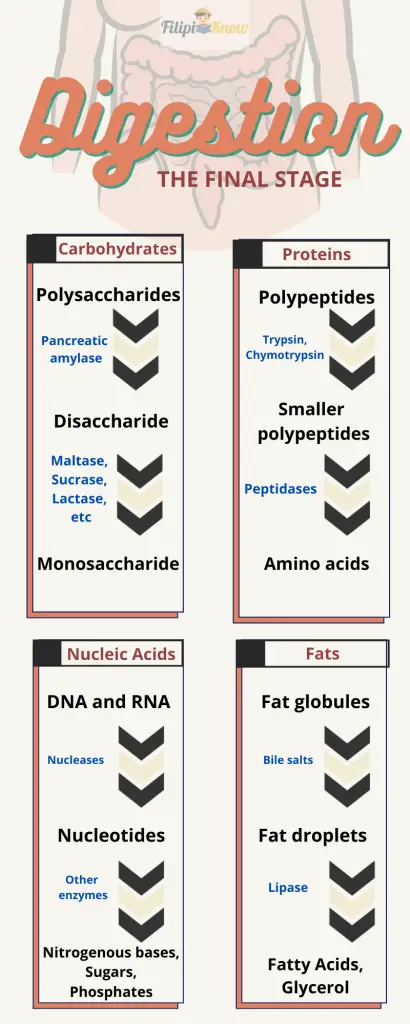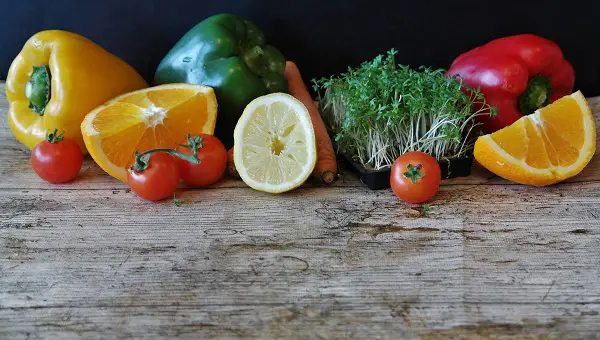Digestive System
The digestive system ingests and digests food, absorbs nutrients, and eliminates undigested food material.
Table of Contents
- How Animals Eat: An Overview
- The Process of Digestion
- Nutrients
- Download Article in PDF Format.
- Test Yourself!
How Animals Eat: An Overview
All animals eat other organisms but the type of diet they feed upon varies extensively.
- Herbivores are those that dine mainly on plants and algae
- Carnivores feed off other animals
- Omnivores are those able to consume both plants and animals
In addition to what they eat, how they eat can also be described as follows:
- Suspension feeders are those that capture food particles from their surrounding environment
- Substrate feeders live in or on their food and eat their way through it
- Fluid feeders suck nutrient-rich liquids from others
- Bulk feeders ingest large pieces of food
The organ system responsible for processing food and for nourishment is the digestive system, and the process of breaking down food can be described as four distinct stages:
- Ingestion, which is the act of eating;
- Digestion, which is the breakdown of food into smaller molecules for the body to absorb;
- Absorption where the byproducts of digestion are taken up by the body; and
- Elimination during which undigested material is removed from the digestive system.

Animals with relatively simple body plans digest food within a gastrovascular cavity that functions as both an entrance for food and an exit for undigested waste. More complex animals have an alimentary canal (we refer to it as the gut) which is a tube extending between the mouth and an anus. Because food moves in one direction, regions of the tube become specialized to digest and absorb nutrients in a stepwise fashion.
The Process of Digestion
Food entering the mouth passes through the pharynx or throat. Depending on the species, the esophagus may channel food into a crop, stomach, or gizzard. A crop is a pouch-like organ where food is softened and stored. Stomachs and gizzards are muscular organs that churn and grind food as well as store food temporarily. Chemical digestion and nutrient absorption occur mainly in the intestine and the undigested materials are expelled through the anus.
In humans, food is mechanically digested as teeth cut, smash, and grind food (a process known as “chewing”, technically called mastication). The presence of food also stimulates three pairs of salivary glands. Saliva contains several substances that are important in food processing. Of particular note is that saliva contains the enzyme amylase which is able to digest starch already.
After food is ingested in the mouth or oral cavity, we use our tongue to push the food, which has been shaped into a ball called a bolus, down our throat. After swallowing, muscles propel food by peristalsis, alternating waves of contraction and relaxation of smooth muscles that line the alimentary canal.
Ring-like muscular valves, called sphincters, regulate the passage of food into and out of the stomach, keeping food there for about 2-6 hours, enough for digestive enzymes to begin digestion. Digestion in the stomach is accompanied by the secretion of gastric juice, which is made up of protein-digesting enzymes, mucus, and a strong acid. The low pH of gastric juice kills most bacteria and other microbes swallowed with food. Another function of the acid is it breaks apart cells in food and denatures proteins.

Three types of cells, the gastric glands, secrete different components of gastric juice:
- Mucous cells secrete mucus which lubricates and protects cells lining the stomach
- Parietal cells secrete hydrogen and chloride ions, forming hydrochloric acid (HCl)
- Chief cells secrete pepsinogen, an inactive form of the enzyme pepsin
When pepsinogen and HCl mix in the stomach, some pepsinogen gets converted into pepsin and helps activate more pepsinogen. This type of reaction is a form of positive feedback since the end product of a process encourages the formation of more end products. Pepsin is important in breaking down proteins.
When the food arrives in the stomach, the hormone gastrin is also released and helps stimulate the release of more gastric juice. When the stomach contents become too acidic, gastrin is inhibited. In a way, the stomach has the means to protect itself from being digested by the combination of its contents.
About every 20 seconds, the stomach muscles contract, churning and mixing its contents. The bolus which enters the stomach soon becomes an acidic, nutrient-rich broth known as chyme. The sphincter between the stomach and the small intestine regulates the passage of the chyme.
The duodenum, referring to the first few inches of the small intestine, is where the chyme mixes with digestive juices from the pancreas, liver, gallbladder, and glands along the intestinal wall.
The pancreas produces pancreatic juice, a mix of digestive enzymes, and an alkaline solution that neutralizes the acidity of chyme in the small intestine.
The liver produces bile, a mixture of salts that acts as emulsifiers, allowing fats to be broken into small droplets that can be dissolved by digestive enzymes.
The gallbladder stores and concentrates the bile until it is needed in the small intestine. When this bile crystallizes, this may result in gallstones. The chyme entering the duodenum stimulates the release of the different secretions.
The final steps of digestion and absorption occur in the small intestine for about 5-6 hours. Different enzymes aid digestion in the small intestine and are summarized in the following infographic:

The texts in blue are the materials or enzymes needed to break down the complex food molecules. Aside from digestion, absorption of nutrients also occurs in the small intestine at the regions after the duodenum: the jejunum and ileum. The inner walls of the small intestine are lined by circular folds with numerous small, finger-like projections called villi.
Each epithelial cell on the surface of a villus has many microscopic projections called microvilli. This structure increases the surface area that makes absorption of nutrients more efficient. In addition, the villi also contain blood capillaries and this allows the completely broken-down food to be transported easily into the bloodstream. This blood then proceeds to the liver through the hepatic portal vein where the blood gets processed.
The location of the liver, between the intestines and the heart, allows it access to nutrients absorbed in the intestines. The liver removes excess glucose in the blood and converts it to glycogen, a function that is important in regulating metabolism.
In addition, the liver can modify and detoxify substances absorbed by the digestive tract before the blood carries it to the rest of the body. It converts toxins into inactive products that are excreted in the urine.
The undigested material moves slowly through the large intestine (taking 12-24 hours).
At the T-shaped junction between the small and large intestine, a sphincter controls passage into a pouch called the cecum. In mammals, this cecum has a finger-like extension containing white blood cells called the appendix, the infection and inflammation of which may be caused by blockage of the junction between it and the large intestine or through bacterial infection.
The main portion of the large intestine is the colon where one of its main functions is to reabsorb water which began in the small intestine. The wastes of the digestive system, fecal matter (or feces), become more solid as water is reabsorbed as it passes through the large intestine. It is then stored in the rectum and expelled through the anus.
Nutrients are important components that we acquire from food that nourishes us and help us maintain our health. In the next topic, we will look closer at the different nutrients we acquire from food.
Nutrients
Digestion breaks large molecules in food into forms that the body can absorb. Once absorbed, the molecules from food are used to provide energy to power cellular work; as building blocks for other biomolecules; and as essential nutrients important in maintaining health.
The energy we get from food is measured in calories. One calorie refers to the amount of energy required to raise the temperature of a gram of water by 1 0C. The calories listed on food labels are actually kilocalories (1000 calories or 1 kcal) and are often written as Calories.
Besides providing fuel and raw organic materials, an animal’s diet supplies essential nutrients, substances an animal requires but cannot assemble from simple organic molecules. In short, the absence of these nutrients in our bodies leads to illnesses. Essential nutrients include essential fatty acids, essential amino acids, vitamins, and minerals.

Our bodies are able to synthesize most of the fatty acids we need. However, those we cannot make are called essential fatty acids. One example is linoleic acid (belonging to the omega-6 family of fatty acids) which is used to make some phospholipids of cell membranes. We obtain ample amounts of essential fatty acids from plant-based food.
Out of the 20 different amino acids, 12 can be made in the body and the remaining eight are the essential amino acids. A ninth is required in infants in the form of histidine. The deficiency of a single acid impairs protein synthesis. The animal by-products of eggs, milk, and cheese are said to be “complete” proteins as they provide adequate amounts of all the essential amino acids.
A vitamin is an organic molecule required in very small amounts in our diet. Vitamins can be water-soluble or fat-soluble. Water-soluble vitamins include the B vitamins and vitamin C. The B vitamins function as coenzymes, which are used over and over in metabolic reactions while vitamin C is used to produce connective tissue. The fat-soluble vitamins are vitamins A, D, E, and K. The following is a list of the 13 essential vitamins:
| Water-Soluble Vitamins | Fat-Soluble Vitamins |
| B Vitamins | Vitamin A (retinol) |
| B1 (thiamine) | Vitamin D |
| B2 (riboflavin) | Vitamin E (tocopherol) |
| B3 (niacin) | Vitamin K |
| B5 (pantothenic acid) | |
| B6 (pyridoxine) | |
| B7 (biotin) | |
| B9 (folic acid) | |
| B12 (cobalamin) | |
| Vitamin C (ascorbic acid) |
Minerals are inorganic nutrients required in small amounts. The following lists our mineral requirements with those on the right column required in trace amounts:
| Calcium | Chromium |
| Phosphorus | Cobalt |
| Sulfur | Copper |
| Potassium | Manganese |
| Chlorine | Molybdenum |
| Sodium | Selenium |
| Magnesium | Zinc |
| Iron | |
| Fluorine | |
| Iodine |
Calcium and phosphorus are important in constructing and maintaining the bones of our skeleton. Iron is needed in constructing hemoglobin which is a component of red blood cells. Iodine is a component of thyroid hormones that help regulate metabolic rate. Sodium, potassium, and chlorine help in nerve function and maintain osmotic balance in cells.

If our diet lacks calories or one or more essential nutrients, the result is malnutrition. Excess leads to obesity as it is defined as having a too high body mass index (BMI) value, a ratio of weight to height.
Size is not the only factor influenced by our diet; it also plays into whether we risk developing serious illnesses. Cholesterol, for example, travels the body while bound to a protein. High blood levels of cholesterol-carrying particles called low-density lipoproteins (LDLs) generally correlate with a tendency of blocked blood vessels, high blood pressure, and heart attacks (and so are called “bad cholesterol”). In contrast, high-density lipoproteins (HDLs) may decrease the risk of blocking blood vessels as HDLs convey excess cholesterol to the liver, where it gets broken down.
Food is one necessity for life, another is being able to breathe. In the next chapter, we will examine the organ system that facilitates respiration.
Next topic: Respiratory System
Previous topic: Integumentary System
Return to the main article: Animal Form and Functions (Overview)
Download Article in PDF Format.
Test Yourself!
1. Practice Questions [PDF Download]
2. Answer Key [PDF Download]
Copyright Notice
All materials contained on this site are protected by the Republic of the Philippines copyright law and may not be reproduced, distributed, transmitted, displayed, published, or broadcast without the prior written permission of filipiknow.net or in the case of third party materials, the owner of that content. You may not alter or remove any trademark, copyright, or other notice from copies of the content. Be warned that we have already reported and helped terminate several websites and YouTube channels for blatantly stealing our content. If you wish to use filipiknow.net content for commercial purposes, such as for content syndication, etc., please contact us at legal(at)filipiknow(dot)net
